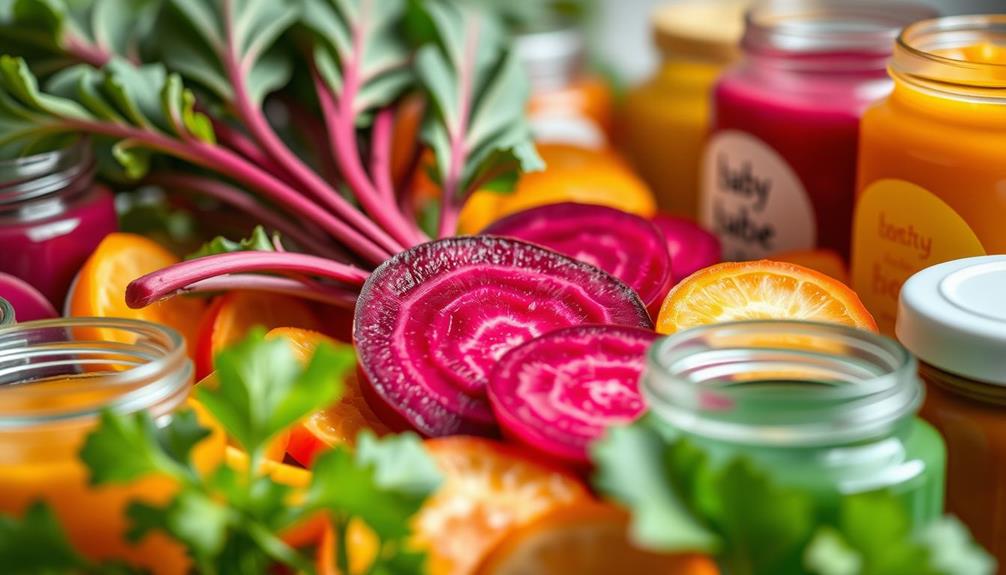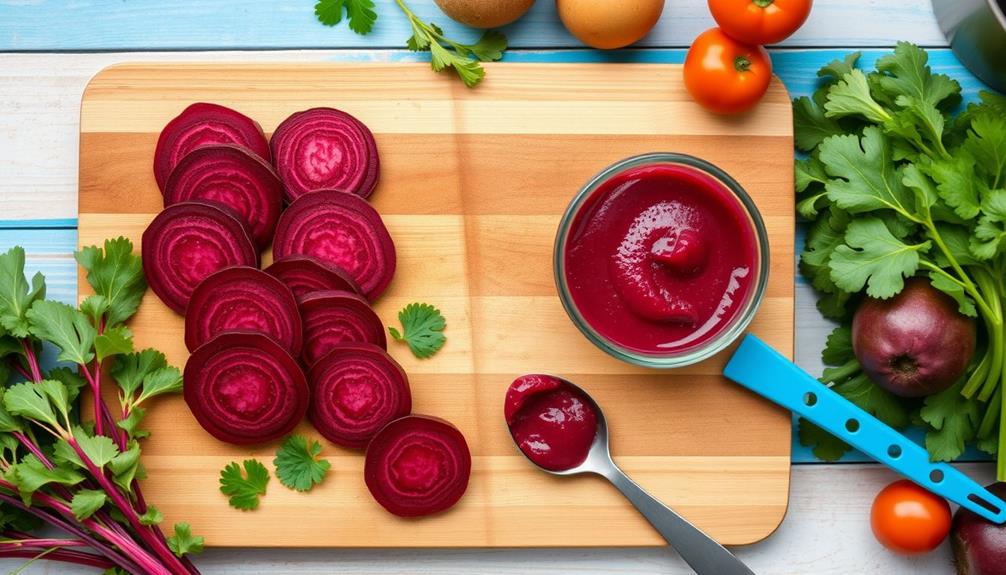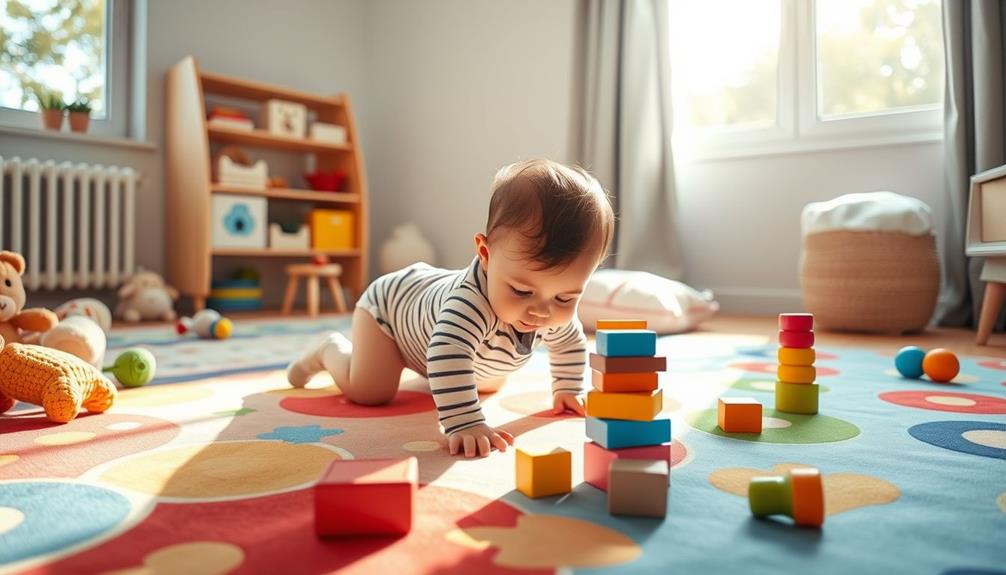Beetroot is a fantastic superfood for your baby or toddler. It's rich in folate, potassium, and fiber, supporting growth, digestion, and overall health. You'll find that its non-heme iron helps prevent anemia, while antioxidants boost immunity. Start with soft, mashed beets around six months, then gradually introduce quartered pieces for self-feeding. Beetroot is safe for little ones, especially when cooked properly. Just keep an eye out for any reactions initially. Incorporating beetroot can be easy and fun, and you'll discover even more creative ways to add this nutrient powerhouse to your child's meals.
Key Takeaways
- Beetroot is rich in folate, potassium, and manganese, supporting healthy growth and muscle development in babies and toddlers.
- The high fiber content in beetroot aids digestion and helps prevent constipation in young children.
- Non-heme iron in beets promotes blood cell production, reducing the risk of anemia in infants and toddlers.
- Beetroot is low in calories, making it a nutritious addition to a child's diet without excess calories.
- Properly prepared beetroot is generally safe for babies, with rare allergies, and offers various serving options for different ages.
Nutritional Benefits of Beetroot
When it comes to introducing nutritious foods to your little ones, beetroot stands out as a powerhouse of essential nutrients. These vibrant beets are loaded with essential vitamins and minerals that can greatly benefit your child's health. A cup of cooked beets offers an impressive amount of folate, providing 34% of the daily value (DV), which is vital for healthy growth and development.
Regular physical activity supports ideal nutrient absorption and overall health, making beetroot a fantastic addition to an active child's diet. Additionally, incorporating mindful eating practices can help your little ones develop a positive relationship with food.
You'll also find potassium and manganese in beets, accounting for 11% and 24% of the DV, respectively. This combination of vitamins and minerals supports strong muscles, bones, and proper bodily functions.
Plus, with 3.4g of dietary fiber per cup, beetroot aids digestion and helps prevent constipation, making it a smart choice for babies and toddlers.
The non-heme iron in beets is another highlight, as it promotes blood cell production and helps prevent anemia in young children. With only 44 calories per 100-gram serving, you can easily incorporate beetroot into your child's diet without worrying about excessive energy intake.
Regularly enjoying beetroot can enhance hydration and energy levels, supporting ideal growth and development in your little ones.
Safety and Allergenicity

Introducing new foods to your child can bring a mix of excitement and apprehension, especially when it comes to potential allergies. Fortunately, beet allergies are rare, making beets generally safe for babies and toddlers when introduced properly.
To guarantee safety and allergenicity, start by offering small amounts of cooked beets and monitor for any adverse reactions. If no negative symptoms occur, you can gradually increase the serving size. It's important to keep in mind that the preparation of these foods is vital, just as having a well-prepared cleaning kit is for maintaining a healthy home environment.
Beets contain beneficial nutrients that contribute to a healthy weight and overall wellness. However, be cautious about choking hazards by making sure the beets are cooked until soft and cut into appropriate sizes for young children. This simple preparation will help reduce the risk of choking while letting your child enjoy the nutritional benefits of beets.
It's worth noting that the nitrates present in beets aren't a significant concern for babies, as a balanced diet typically mitigates any potential risks associated with excessive consumption.
Serving Suggestions for Different Ages

Beetroot can be a nutritious addition to your baby's diet, and serving suggestions vary based on age to assure safe and enjoyable consumption.
It's important to introduce new foods gradually to monitor for any allergies or reactions, especially when incorporating a balanced diet rich in proteins like beets.
Here's how to introduce beets based on your child's age:
- 6 months old: Serve cooked beets that are soft and mashed. This guarantees easy consumption and digestion. Start with small serving sizes to prevent any digestive discomfort.
- 9 months old: Offer quartered soft pieces of beets. This allows your baby to practice self-feeding with bite-sized options, making it fun and engaging to eat beets.
- 12 months old: Introduce cooked or raw shredded beets in mixed dishes. This encourages toddlers to use utensils and develop motor skills.
- Monitor changes: Keep an eye on color changes in poop and urine after consumption; this is normal and typically harmless.
- Gradually increase serving sizes: As your little one becomes accustomed to the flavor and texture, you can slowly increase how much you serve to enjoy the health benefits of beets.
Health Benefits for Development

Adding beetroot to your child's diet offers numerous health benefits that support their development. Rich in essential nutrients like folate, potassium, and vitamin C, beetroot juice plays an important role in healthy brain development and immune function. These nutrients help guarantee your little one's brain grows strong and sharp, setting the foundation for learning.
Additionally, variety of perspectives on healthy living trends highlight how incorporating colorful vegetables like beetroot can make meals more appealing to children.
The high fiber content in beetroot aids digestion and can alleviate constipation, promoting a healthy digestive system. Plus, the non-heme iron found in beets is essential for blood cell production, helping to prevent anemia and guaranteeing adequate oxygen transport in your child's growing body. This is critical for maintaining energy levels and stamina, encouraging active play and physical growth.
Moreover, beetroot's antioxidants enhance immune function, providing your child with added protection against infections. Regular consumption can also help regulate blood pressure, supporting overall health in infants and toddlers.
Culinary Ideas and Recipes

Exploring culinary options for your little one can be a delightful journey, especially when it comes to incorporating the vibrant and nutritious beetroot into their meals.
Beets aren't only colorful but also packed with nitrates, which can support heart health. Additionally, beets are rich in vitamins and minerals that are essential for your child's growth and development, making them a perfect addition to their diet.
Here are some fun culinary ideas to introduce beets to your baby's diet:
- Mashed Beets: Cook beets until soft, then mash and serve for babies around 6 months.
- Quartered Beets: By 9 months, offer quartered, soft pieces to encourage self-feeding.
- Beet Salad: At 12 months, mix shredded cooked or raw beets into salads or grain dishes for a nutritious boost.
- Beet Smoothies: Blend cooked beets with fruits like bananas or apples for a naturally sweet drink that hydrates and nourishes.
- Beet and Grain Bowl: Combine cooked beets with quinoa or rice and soft veggies for a balanced meal.
These culinary ideas not only make mealtime enjoyable but also introduce your child to the health benefits of beets, helping to lay the foundation for a heart-healthy future.
For more tips on enhancing your child's diet with nutritious ingredients, consider exploring high-quality home printers that can print fun recipe cards!
Frequently Asked Questions
Is Beetroot Good for a Baby?
Yes, beetroot can be good for your baby! You can introduce it around six months, as it's packed with essential nutrients like folate, potassium, and vitamin C.
These nutrients support energy, digestion, and immune function. Plus, the high fiber content helps maintain healthy digestion and can ease constipation.
Just introduce it in small amounts and gradually increase, as beet allergies are rare. Overall, it's a nutritious option for your little one!
Can Kids Drink Beetroot Juice Daily?
Imagine your little one sipping on a vibrant glass of beetroot juice, a swirl of deep crimson tempting their taste buds.
Yes, kids can drink beetroot juice daily, but moderation's key. Aim for about 120-240 ml, keeping an eye out for any signs of discomfort.
This nutrient-packed drink can boost their growth and digestion.
Just remember, it's normal for their urine to turn pink or red—it's all part of the beetroot magic!
What Is the Difference Between Beetroot and Baby Beetroot?
The difference between beetroot and baby beetroot lies mainly in their size and maturity.
You'll notice that mature beetroot is larger, with a more intense flavor, while baby beetroot is smaller, sweeter, and milder.
Nutritionally, mature beetroot has more carbohydrates and fiber, whereas baby beetroot offers higher water content and certain vitamins, like vitamin C.
Both can be enjoyed in various dishes, but baby beetroot is often preferred raw or lightly cooked to preserve its delicate texture.
Is Beet Root Powder Safe for Toddlers?
Did you know that beetroot contains about 20% of the daily recommended intake of folate?
When you consider introducing beetroot powder to your toddler's diet, it can be safe if done in moderation and around 12 months of age.
It's packed with essential nutrients that support growth and digestion.
Just make certain to get it from a trusted source and consult your healthcare provider to guarantee it meets your child's dietary needs.
Conclusion
So, while you might think beetroot's vibrant color could scare little ones away, it turns out they may actually love it! Packed with nutrients, this superfood supports their growth and development, making it a surprising ally in their diets. Who knew something so visually striking could be so beneficial? Embrace the irony: what looks like a vegetable villain is really a superhero in disguise, ready to boost your baby's health and culinary adventures. Give it a try!










